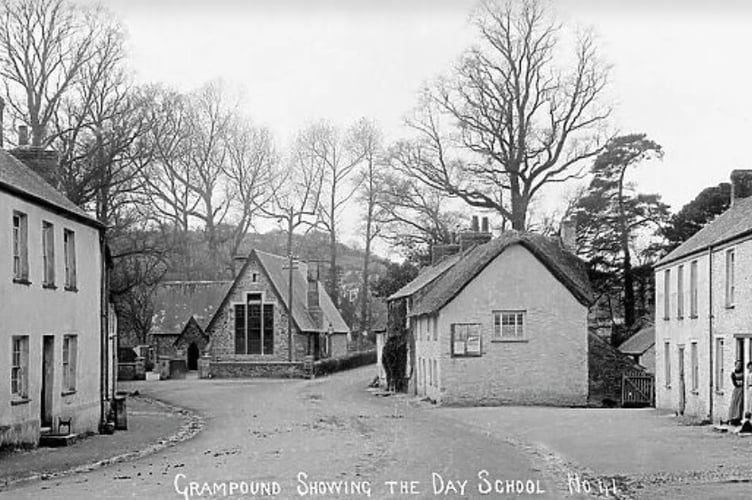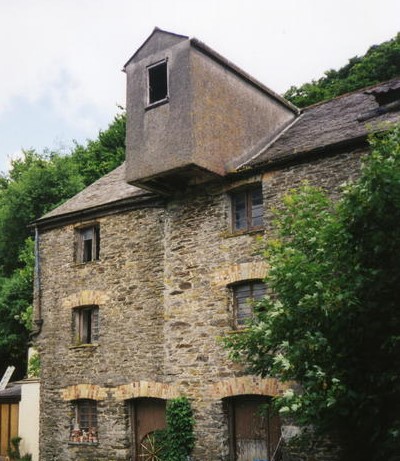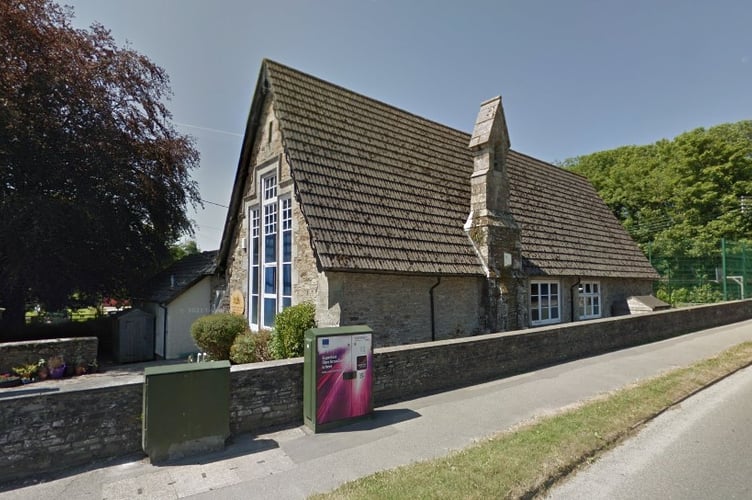The Grampound with Creed Heritage Centre which was badly damaged in December 2022 when a car crashed into the southeast corner demolishing a sizeable part of the building is now fully repaired.
The heritage centre which is located in Grampound's 18th century Grade II listed town hall needed to close and have all the artefacts removed until the rebuilding work was completed. It now seems an opportunity to share something of this parish and its history to celebrate the reopening of this important community space.
Grampound itself was first mentioned as Ponsmur in 1296, similar to today’s spelling in Kernewek, Ponsmeur, meaning great bridge. There are other medieval settlements mentioned earlier in the area Penbetha in 969, Penwarne in 1198 and Bossilian in 1296 at the same time as Ponsmur. To the northeast of Grampound are the remains of an Iron Age/Romano British enclosure and rounds of six known ones surrounding the village. The manor of Tybesta belonging to the tenant in chief, the Earl of Cornwall Robert of Mortain, was mentioned in Domesday in 1086. By 1296 the settlement, later known as Grampound, grew around the bridge on both sides of the River Fal which runs through the village. The first bridge is believed to have been built in 1250 during the time of Richard Earl of Cornwall and it is a version of his shield with a lion rampant surrounded by bezants that is seen on the bridge, within the seal of the Borough of Grampound. It is suggested that Richard granted the first charter around that time and later confirmed by his son Edmund as Earl of Cornwall. In 1332 a further charter was granted by John of Eltham the last earl of Cornwall before it became a duchy. This 1332 charter gave extensive privileges to Grampound including a weekly market, fairs, a manorial mill, and a gild merchant freedom from tolls. The Hundred Court of Powder was moved into the town. Records confirm the existence of the borough predates the charter of John of Eltham as in 1297 there were 28 rent paying burgesses.

During medieval times for a town to be successful there was a need for a regular market and even better if it was granted permission to hold a fair. Grampound had both, the market being established by 1296 and over 300 years later in 1602 Richard Carew wrote that the market was held on Saturdays for ‘butchers meat’ and three fairs a year for cattle during January, March and June with the one held on June 11 being one of Cornwall’s largest. Markets continued in Grampound into the 19th century, then larger growing towns and centres of trade led to the decline of smaller town and village markets until they gradually died out.
One of the reasons perhaps for the size of the cattle markets was the thriving tanning industry carried on in Grampound. This had been taking place from at least the mid-17th century and likely very much earlier. A lease shows John Croggon started tanning in Grampound in 1712. It is believed he had a partner Peter Hearle whose family had its own tanning interests back to the 1600’s. The Croggon family business continued under different family members with various other businessmen developing their own tanning yards in Grampound. All of these were amalgamated in 1906 under William Croggan, forming Manor Tannery. This was a traditional tannery using oak bark tanning techniques producing high quality heavy leather, one of few in Britain. The business closed in early 2000.

Creed itself consists of the church and a few houses and was once the name of the civil parish. In 1983 this was abolished, and the new parish of Grampound with Creed formed. The church of St Crida remains the parish church for the Grampound with Creed district. The church was built originally during the 12th century for the Manor of Tybesta and was extensively rebuilt during the 15th century. The architect Edmund H Sedding notes in his ‘Norman architecture in Cornwall’ there are a number of remaining earlier features. The tower originally built in 1447 was as the historian Charles Henderson noted rebuilt in 1773 and unaltered. There was a decline in the fabric of the church during the late 19th century and a restoration was required and carried out in 1904. The church is noted for its light airy feeling. Due to the distance between the growing settlement at Grampound a chapel of ease was established around 1370, dedicated to either St Mary or St Barnabus and said to have been in good repair in 1745. Through lack of attention and maintenance by 1815 it was in a ruinous state and demolished. For a further 70 years no chapel of ease existed in Grampound until 1869 when after rebuilding it was consecrated. Now known as St Nun it is a Grade II listed building and is believed to contain stonework from the original 14th century chapel of ease.
Grampound was one of the many towns visited by John Wesley during the 18th century at the start of Cornwall’s growth in Methodism. The town was in decline and Wesley wrote ‘After spending an hour with friends in Truro, I rode forward to Grampound – a mean inconsiderable dirty village. However, it is a borough town.’ Although the town was poor and on a downward spiral it still held on to the clout of being a borough town for a while longer. A number of nonconformist chapels were built in Grampound but the buildings that still exist have now been converted into residential properties.

Education was not always available to all children until the late 19th century. There was church related education during the medieval period and later from the 16th century the loss of monastic and church schools due to the Reformation made education increasingly dependent on charities into the 18th century. There were grammar schools in larger towns for middleclass boys, but little for the poor. An enquiry into education for the poor in 1818 found the situation in the parish of Creed including Grampound. There was a population of 827 of which 34 were classified as poor, which seems too few. Three un-endowed schools taught 102 children and there were three dame schools, run by women, usually for smaller children and girls who were usually taught home related skills. There was also a nonconformist Sunday school for 50 children. In the town hall the schoolmaster was paid by the local landowner Sir Christopher Hawkins 16 shillings a year, he taught 30 boys and as many girls and then an evening school with 30 pupils and a few on Sunday’s. There had been another school until about 1790 established by the Buller family set up to teach the poor in 1640, but funds dried up and the school closed. Education in Grampound in 1833 relied on it being paid for by parents. By 1869 a national school had been built, and this still exists today as the Grampound and Creed School.
Towards the end of Edward VI’s reign Grampound was granted the privilege of returning two members to parliament. The Tudor period was when Cornwall became renowned for the number of parliamentary representatives added to what later became a large number, known as rotten or pocket boroughs. The whole electoral system throughout Britain was corrupt and new larger towns totally unrepresented with its own late local landowner Sir Christopher Hawkins renowned as a voracious boroughmonger. In 1821 Grampound was the first to lose its electoral franchise, due to bribery, and eleven years later with the Great Reform Act many Cornish towns and boroughs would also suffer disenfranchisement.

Located between St Austell and Truro, Grampound lies in what is largely a rural farming district. Many of these farms have names that stretch back many centuries, some of which were the early settlements in this area of Cornwall. Tregonjohn Farm was recorded in 1338 as Tregonsonan, Nancor just outside Grampound was first mentioned in 1287 and has an 18th century Grade II listed farmhouse. These just two examples of the historic nature of the occupancy in the vicinity of Grampound with Creed. The church itself had a sizeable area of glebe land attached to the church with the River Fal running close by this small churchtown settlement. The nearby river led to opportunities for watermills with leats channelling water where it was needed. Records show that there were watermills in the area from at least the 14th century and used for both grinding grist (oats, corn, barley) and also as fulling mills in the preparation of cloth for weaving. A weir was built or at least rebuilt in 1667 on the Fal close to Creed for the mills at nearby Golden.
Grampound is very different from the town John Wesley spoke of disparagingly in the 18th century. It is clean and has a great community spirit, whilst retaining a good number of Grade II listed buildings. The Grampound Village Hall is a superb venue for all sorts of activities including theatrical shows; monthly film club evenings; coffee mornings supporting Grampound Carnival; monthly antiques markets; art and craft fairs; Grampound Beer Festival and much more. It has raked seating for 100 persons and public convenience in the grounds are open 24/7. Its football team has been in existence since 1902 and the bowling club since 1927, both having their own modern facilities. Along with a children’s play area this makes a great recreational area in the heart of the village. Grampound is a village offering its community much more than larger towns, and today a place to be proud of.
![Grampound showing old town clock c1900 Photo by Samuel John Govier [Royal Cornwall Museum].jpg](https://www.cornish-times.co.uk/tindle-static/image/2024/03/28/11/13/Grampound%20showing%20old%20town%20clock%20c1900.jpg?trim=0,14,0,172&width=752&height=500&crop=752:500)



